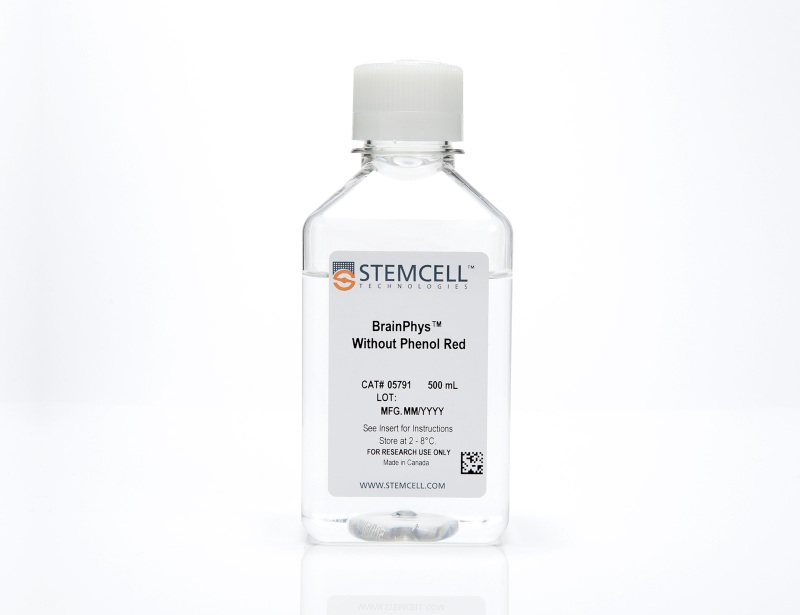BrainPhys™ Without Phenol Red
Serum-free neurophysiological basal medium for improved neuronal function
概要
BrainPhys™ Without Phenol Red is a defined and serum-free neuronal basal medium. BrainPhys™ Without Phenol Red may be used to culture primary neurons or neurons derived from human embryonic stem (ES) cells and induced pluripotent stem (iPS) cells. Based on the formulation published by Cedric Bardy and Fred H. Gage (C Bardy et al. Proc Natl Acad Sci USA, 2015), BrainPhys™ is more representative of the central nervous system extracellular environment and increases the proportion of synaptically active neurons. Applications of BrainPhys™ Without Phenol Red include culture of primary neurons, differentiation and maturation of human ES/iPS cell-derived neurons, microelectrode array-based recording of neuronal activity, live in vitro fluorescent imaging (including calcium imaging and optogenetic stimulation and recording) and transdifferentiation (lineage conversion) of somatic cells to neurons.
To ensure cell survival in long-term serum-free culture, BrainPhys™ Without Phenol Red must be combined with an appropriate serum-replacement supplement, such as NeuroCult™ SM1 Neuronal Supplement (Catalog #05711) and/or N2 Supplement-A (Catalog #07152).
To ensure cell survival in long-term serum-free culture, BrainPhys™ Without Phenol Red must be combined with an appropriate serum-replacement supplement, such as NeuroCult™ SM1 Neuronal Supplement (Catalog #05711) and/or N2 Supplement-A (Catalog #07152).
Advantages
• More representative of the brain’s extracellular environment
• Improved neuronal function and a higher proportion of synaptically active neurons
• Perform functional assays without changing media and shocking cells
• Supports long-term culture of ES/iPS cell- and CNS-derived neurons
• Rigorous raw material screening and quality control ensure minimal lot-to-lot variability
• Improved neuronal function and a higher proportion of synaptically active neurons
• Perform functional assays without changing media and shocking cells
• Supports long-term culture of ES/iPS cell- and CNS-derived neurons
• Rigorous raw material screening and quality control ensure minimal lot-to-lot variability
Subtype
Basal Media, Specialized Media
Cell Type
Neural Cells, PSC-Derived, Neurons, Pluripotent Stem Cells
Species
Human, Mouse, Rat
Application
Cell Culture, Differentiation, Maintenance
Brand
BrainPhys
Area of Interest
Disease Modeling, Drug Discovery and Toxicity Testing, Neuroscience, Stem Cell Biology
Formulation
Serum-Free
技术资料
| Document Type | 产品名称 | Catalog # | Lot # | 语言 |
|---|---|---|---|---|
| Product Information Sheet | BrainPhys™ Without Phenol Red | 05791 | All | English |
| Safety Data Sheet | BrainPhys™ Without Phenol Red | 05791 | All | English |
数据及文献
Publications (2)
American journal of human genetics 2019
Mutations in ACTL6B Cause Neurodevelopmental Deficits and Epilepsy and Lead to Loss of Dendrites in Human Neurons.
Abstract
Abstract
We identified individuals with variations in ACTL6B, a component of the chromatin remodeling machinery including the BAF complex. Ten individuals harbored bi-allelic mutations and presented with global developmental delay, epileptic encephalopathy, and spasticity, and ten individuals with de novo heterozygous mutations displayed intellectual disability, ambulation deficits, severe language impairment, hypotonia, Rett-like stereotypies, and minor facial dysmorphisms (wide mouth, diastema, bulbous nose). Nine of these ten unrelated individuals had the identical de novo c.1027G{\textgreater}A (p.Gly343Arg) mutation. Human-derived neurons were generated that recaptured ACTL6B expression patterns in development from progenitor cell to post-mitotic neuron, validating the use of this model. Engineered knock-out of ACTL6B in wild-type human neurons resulted in profound deficits in dendrite development, a result recapitulated in two individuals with different bi-allelic mutations, and reversed on clonal genetic repair or exogenous expression of ACTL6B. Whole-transcriptome analyses and whole-genomic profiling of the BAF complex in wild-type and bi-allelic mutant ACTL6B neural progenitor cells and neurons revealed increased genomic binding of the BAF complex in ACTL6B mutants, with corresponding transcriptional changes in several genes including TPPP and FSCN1, suggesting that altered regulation of some cytoskeletal genes contribute to altered dendrite development. Assessment of bi-alleic and heterozygous ACTL6B mutations on an ACTL6B knock-out human background demonstrated that bi-allelic mutations mimic engineered deletion deficits while heterozygous mutations do not, suggesting that the former are loss of function and the latter are gain of function. These results reveal a role for ACTL6B in neurodevelopment and implicate another component of chromatin remodeling machinery in brain disease.
Molecular neurodegeneration 2018
iPSC-derived familial Alzheimer's PSEN2 N141I cholinergic neurons exhibit mutation-dependent molecular pathology corrected by insulin signaling.
Abstract
Abstract
BACKGROUND Type 2 diabetes (T2D) is a recognized risk factor for the development of cognitive impairment (CI) and/or dementia, although the exact nature of the molecular pathology of T2D-associated CI remains obscure. One link between T2D and CI might involve decreased insulin signaling in brain and/or neurons in either animal or postmortem human brains as has been reported as a feature of Alzheimer's disease (AD). Here we asked if neuronal insulin resistance is a cell autonomous phenomenon in a familial form of AD. METHODS We have applied a newly developed protocol for deriving human basal forebrain cholinergic neurons (BFCN) from skin fibroblasts via induced pluripotent stem cell (iPSC) technology. We generated wildtype and familial AD mutant PSEN2 N141I (presenilin 2) BFCNs and assessed if insulin signaling, insulin regulation of the major AD proteins Abeta$ and/or tau, and/or calcium fluxes is altered by the PSEN2 N141I mutation. RESULTS We report herein that wildtype, PSEN2 N141I and CRISPR/Cas9-corrected iPSC-derived BFCNs (and their precursors) show indistinguishable insulin signaling profiles as determined by the phosphorylation of canonical insulin signaling pathway molecules. Chronic insulin treatment of BFCNs of all genotypes led to a reduction in the Abeta$42/40 ratio. Unexpectedly, we found a CRISPR/Cas9-correctable effect of PSEN2 N141I on calcium flux, which could be prevented by chronic exposure of BFCNs to insulin. CONCLUSIONS Our studies indicate that the familial AD mutation PSEN2 N141I does not induce neuronal insulin resistance in a cell autonomous fashion. The ability of insulin to correct calcium fluxes and to lower Abeta$42/40 ratio suggests that insulin acts to oppose an AD-pathophysiology. Hence, our results are consistent with a potential physiological role for insulin as a mediator of resilience by counteracting specific metabolic and molecular features of AD.


